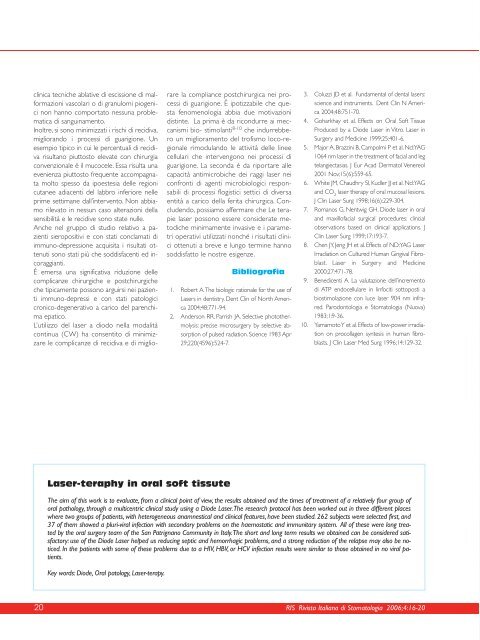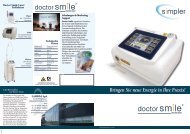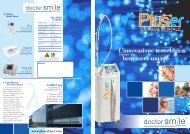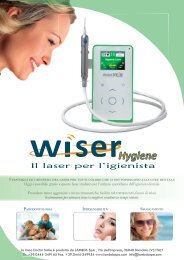terapie laser assistite dei tessuti molli orali - doctor smile
terapie laser assistite dei tessuti molli orali - doctor smile
terapie laser assistite dei tessuti molli orali - doctor smile
You also want an ePaper? Increase the reach of your titles
YUMPU automatically turns print PDFs into web optimized ePapers that Google loves.
clinica tecniche ablative di escissione di malformazioni<br />
vascolari o di granulomi piogenici<br />
non hanno comportato nessuna problematica<br />
di sanguinamento.<br />
Inoltre, si sono minimizzati i rischi di recidiva,<br />
migliorando i processi di guarigione. Un<br />
esempio tipico in cui le percentuali di recidiva<br />
risultano piuttosto elevate con chirurgia<br />
convenzionale è il mucocele. Essa risulta una<br />
evenienza piuttosto frequente accompagnata<br />
molto spesso da ipoestesia delle regioni<br />
cutanee adiacenti del labbro inferiore nelle<br />
prime settimane dall’intervento. Non abbiamo<br />
rilevato in nessun caso alterazioni della<br />
sensibilità e le recidive sono state nulle.<br />
Anche nel gruppo di studio relativo a pazienti<br />
sieropositivi e con stati conclamati di<br />
immuno-depressione acquisita i risultati ottenuti<br />
sono stati più che soddisfacenti ed incoraggianti.<br />
È emersa una significativa riduzione delle<br />
complicanze chirurgiche e postchirurgiche<br />
che tipicamente possono arguirsi nei pazienti<br />
immuno-depressi e con stati patologici<br />
cronico-degenerativo a carico del parenchima<br />
epatico.<br />
L’utilizzo del <strong>laser</strong> a diodo nella modalità<br />
continua (CW) ha consentito di minimizzare<br />
le complicanze di recidiva e di migliorare<br />
la compliance postchirurgica nei processi<br />
di guarigione. È ipotizzabile che questa<br />
fenomenologia abbia due motivazioni<br />
distinte. La prima è da ricondurre ai meccanismi<br />
bio- stimolanti 8-10 che indurrebbero<br />
un miglioramento del trofismo loco-regionale<br />
rimodulando le attività delle linee<br />
cellulari che intervengono nei processi di<br />
guarigione. La seconda è da riportare alle<br />
capacità antimicrobiche <strong>dei</strong> raggi <strong>laser</strong> nei<br />
confronti di agenti microbiologici responsabili<br />
di processi flogistici settici di diversa<br />
entità a carico della ferita chirurgica. Concludendo,<br />
possiamo affermare che Le <strong>terapie</strong><br />
<strong>laser</strong> possono essere considerate metodiche<br />
minimamente invasive e i parametri<br />
operativi utilizzati nonché i risultati clinici<br />
ottenuti a breve e lungo termine hanno<br />
soddisfatto le nostre esigenze.<br />
Bibliografia<br />
1. Robert A.The biologic rationale for the use of<br />
Lasers in dentistry. Dent Clin of North America<br />
2004;48:771-94.<br />
2. Anderson RR, Parrish JA. Selective photothermolysis:<br />
precise microsurgery by selective absorption<br />
of pulsed radiation. Science 1983 Apr<br />
29;220(4596):524-7.<br />
3. Coluzzi JD et al. Fundamental of dental <strong>laser</strong>s:<br />
science and instruments. Dent Clin N America<br />
2004;48:751-70.<br />
4. Goharkhay et al. Effects on Oral Soft Tissue<br />
Produced by a Diode Laser in Vitro. Laser in<br />
Surgery and Medicine 1999;25:401-6.<br />
5. Major A, Brazzini B, Campolmi P et al. Nd:YAG<br />
1064 nm <strong>laser</strong> in the treatment of facial and leg<br />
telangiectasias. J Eur Acad Dermatol Venereol<br />
2001 Nov;15(6):559-65.<br />
6. White JM, Chaudhry SI, Kudler JJ et al. Nd:YAG<br />
and CO 2<br />
<strong>laser</strong> therapy of oral mucosal lesions.<br />
J Clin Laser Surg 1998;16(6):229-304.<br />
7. Romanos G, Nentwig GH. Diode <strong>laser</strong> in oral<br />
and maxillofacial surgical procedures: clincial<br />
observations based on clinical applications. J<br />
Clin Laser Surg 1999;17:193-7.<br />
8. Chen JY, Jeng JH et al. Effects of ND:YAG Laser<br />
Irradiation on Cultured Human Gingival Fibroblast.<br />
Laser in Surgery and Medicine<br />
2000;27:471-78.<br />
9. Benedicenti A. La valutazione dell’incremento<br />
di ATP endocellulare in linfociti sottoposti a<br />
biostimolazione con luce <strong>laser</strong> 904 nm infrared.<br />
Parodontologia e Stomatologia (Nuova)<br />
1983;1:9-36.<br />
10. Yamamoto Y et al. Effects of low-power irradiation<br />
on procollagen syntesis in human fibroblasts.<br />
J Clin Laser Med Surg 1996;14:129-32.<br />
Laser-teraphy in oral soft tissute<br />
The aim of this work is to evaluate, from a clinical point of view, the results obtained and the times of treatment of a relatively four group of<br />
oral pathology, through a multicentric clinical study using a Diode Laser.The research protocol has been worked out in three different places<br />
where two groups of patients, with heterogeneous anamnestical and clinical features, have been studied. 262 subjects were selected first, and<br />
37 of them showed a pluri-viral infection with secondary problems on the haemostatic and immunitary system. All of these were long treated<br />
by the oral surgery team of the San Patrignano Community in Italy.The short and long term results we obtained can be considered satisfactory:<br />
use of the Diode Laser helped us reducing septic and hemorrhagic problems, and a strong reduction of the relapse may also be noticed.<br />
In the patients with some of these problems due to a HIV, HBV, or HCV infection results were similar to those obtained in no viral patients.<br />
Key words: Diode, Oral patology, Laser-terapy.<br />
20<br />
RIS Rivista Italiana di Stomatologia 2006;4:16-20










